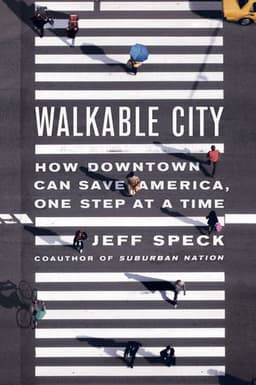
Walkable City by Jeff Speck - 1 Minute Summary
How Downtown Can Save America, One Step at a Time
Book by Jeff Speck
Read the In-Depth 15 Minute Summary
In his influential book "Walkable City," city planner Jeff Speck makes a compelling case for the importance of walkability in creating vibrant, healthy, and sustainable communities. He argues that the way we design our cities has a profound impact on our quality of life, and that by prioritizing pedestrians over cars, we can unlock a wide range of benefits for individuals and society as a whole.
So what exactly is a walkable city? Speck defines it as a place where walking is safe, comfortable, and convenient, and where daily errands and activities can be accomplished on foot. This requires a mix of land uses (housing, shops, offices, schools, parks) in close proximity, as well as pedestrian-friendly street design, with features like wide sidewalks, street trees, and buildings that engage with the sidewalk. Historically, most cities were walkable by necessity, but the rise of the automobile in the 20th century led to a dramatic shift towards sprawling, car-centric development patterns. Speck chronicles how this shift has had devastating consequences for public health, social cohesion, and the environment.
The stakes could not be higher. As Speck illustrates with a wealth of data and examples, walkable cities are healthier, more equitable, and more economically vibrant than their car-dependent counterparts. Residents of walkable neighborhoods are less likely to be obese, have higher levels of social capital and civic engagement, and spend less money on transportation, leaving more to invest in local businesses. Walkable cities are also more resilient in the face of economic and environmental shocks, as they are less reliant on cheap oil and have a smaller carbon footprint.
Looking to the future, Speck envisions a world where walkability is the norm, not the exception. He highlights successful examples of cities that have transformed themselves by prioritizing pedestrians, from Portland to New York to Vancouver. While there is no one-size-fits-all solution, he offers a set of practical strategies and policies that any city can adopt, from redesigning streets to support walking and biking, to reforming zoning codes to allow for more mixed-use development. As more and more people recognize the benefits of walkable cities, Speck predicts that demand for them will only continue to grow, creating a virtuous cycle of investment and improvement.
So what can we as individuals do to support this vision? First and foremost, we can choose to live in walkable neighborhoods whenever possible, and prioritize walking and biking over driving for short trips. We can also advocate for policies and investments that support walkability, from funding for pedestrian infrastructure to zoning reforms that allow for more diverse and affordable housing options. Finally, we can spread the word about the benefits of walkable cities, and help to build a broader movement for change. By working together to create more walkable communities, we can improve our own lives and leave a lasting legacy for future generations.

